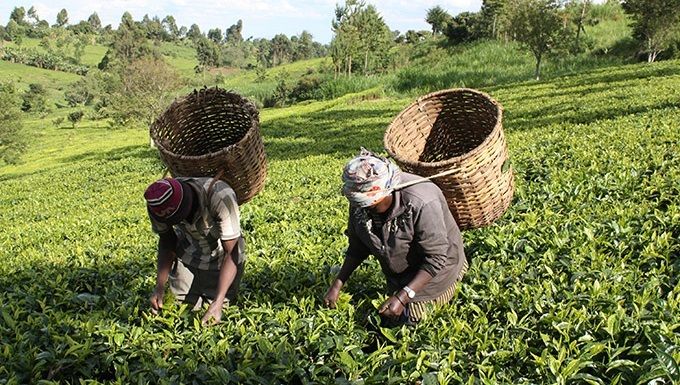
It’s green and lush, but tea farmers in Kenya are feeling the effect of climate change.
The lush tea plantations that blanket the hills of Central Kenya’s Murang’a South district don’t look like a front line in the fight against climate change or deforestation. Trees abound. The bright green tea shrubs look like they could scarcely be denser, or healthier.
As I learned on a visit there this summer, neither the abundant trees nor the thriving tea is an accident. Quite the contrary. The nearly 6,000 smallholder farmers who collectively own the Makomboki Tea Factory north of Nairobi have become leaders both in adapting to changing weather and rainfall patterns, and in reducing firewood use. They have become a model for how the Kenyan tea industry – tea is the country’s biggest export – can build a greener and more prosperous future.
Boosting yields, reversing deforestation
Only a few years ago, the area faced intense deforestation pressures to supply firewood to power the drying and processing of freshly harvested tea leaves into the familiar dark pellets that end up in tea bags. At the same time, farmers were beset by falling crop yields, the result of bouts of extreme heat, prolonged periods of drought, and previously unseen frost where tea cultivation had been forced upwards to higher altitudes.
Since 2010, the International Trade Centre has teamed up with the Ethical Tea Partnership, together with the Kenya Tea Development Agency, to help farmers become more climate resilient, and to train factory managers to slash firewood use and introduce more energy efficient practices.
In the area around the Makomboki Tea Factory, trained field experts now teach farmers new agricultural techniques to maintain yields, incomes and quality in the face of changing circumstances.
Stephen Nganga Mwaniki, one of these experts, explained that having trees near tea bushes can both shade them from excessive heat and protect them from frost. The factory now gives farmers tree seedlings to plant amidst the tea bushes. Harvesting rainwater and introducing drip irrigation, which uses 30% to 70% less water than conventional sprinkling, help farmers draw less water from dwindling local rivers.
Composting tree leaves and branches for fertilizer enriches soil and boosts yields. Better pruning and plucking techniques reduce vulnerability to plant diseases and improve tea quality. Crop diversification has made farmers’ incomes more resilient to fluctuations in tea prices and production volumes.
Improved yields have not been the only pay-off. Alice Wanja Kariuki, who proudly informed me she was Makomboki’s most productive tea farmer, said building a small plant to generate biogas from her cow’s manure meant her family no longer needed firewood as cooking fuel.
Saving on energy costs and reducing emissions
It’s not just the farmers that have changed practices. The operations of the factory itself have also been transformed. After an energy audit and gap analysis, ITC and the Ethical Tea Partnership proposed an energy efficiency strategy together with training on emissions mitigation and energy conservation techniques.
Cutting trees for fuel – both for household and larger-scale use – has been a major driver of deforestation in Kenya. At the Makomboki Tea Factory, personnel were trained to replace firewood with briquettes made of macadamia and cashew nut shells, rice husks, sawdust and other waste materials that would otherwise present a burden for safe disposal. The energy-rich briquettes, which are made on site with specialized machinery, enabled the factory to cut firewood use (and costs) by 100%, saving 20,000 cubic meters of wood – equivalent to about 40,000 to 60,000 trees – per year.
Energy costs for firewood and electricity, which earlier made up 48% of total factory expenditures, have now been cut to 30%, with the savings going into the pockets of the farmers who make up the cooperative.
As the first of the 66 factories affiliated with the Kenya Tea Development Authority to make the full switch to alternative, renewable sources of energy, Makomboki serves as a model for other tea factories in the region. The new practices also tie into other efforts to promote climate-resilient agriculture in Kenya. For instance, coffee farmers who now intercrop with macadamia nut trees to generate new income streams can sell the shells to tea factories to turn into briquettes. While revenues from selling tea traditionally goes into the pockets of men, it is women who pocket the the proceeds from macadamia nuts and avocados. And since women spend up to 90% of their incomes on their families’ health and education, compared to 40% in the case of men, intercropping also offers a faster route to end poverty.
Next step: moving up the value chain
Even before the effects of climate change began to be felt in earnest, farmers, especially in developing countries, have been vulnerable to weather, pests and plant disease. But these are hardly the only threats they have to deal with: agricultural producers and exporters everywhere are affected by supply and price shifts, or changing market trends.
Managers at Makomboki are no exception. With the price outlook uncertain for the type of tea they currently manufacture, they are looking to invest in new processing equipment to make higher-value green tea and so-called ‘orthodox’ tea, recognizable by its long strands of rolled tea leaves and thought to offer a more sophisticated flavour profile.
Climate finance will be high on the agenda at the United Nations climate conference (COP22) in Marrakesh this month. As the Paris Agreement on climate change enters into force, Makomboki provides a powerful example of how embedding climate-resilient practices from farm to factory can maintain yields, safeguard incomes, address poverty and reduce carbon emissions. It shows that well-targeted investments can deliver adaptation, mitigation, and improved livelihoods.
